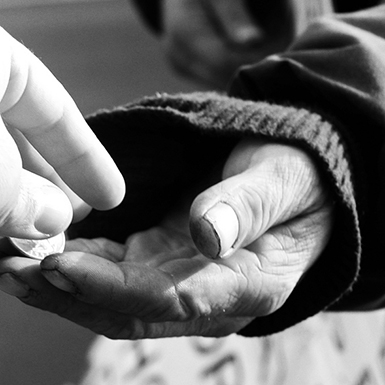The widespread stigmatization and criminalization of begging is often ethnicised and in contemporary Europe, begging as a ‘social evil’ has received particular attention in the context of migration from Romania and Bulgaria, with begging frequently being associated with Roma, and management of begging therefore becoming a mechanism of controlling the migration of Roma. As part of the bEUcitizen WP10 project ‘Insiders and Outsiders’ we conducted a media analysis of how beggars and begging are constituted in media discourses. The media analysis conducted for this study reveals a strong association between Roma and begging. The racialized figure of the Roma beggar is outside of societal norms and inclusion in the community, and constructed as an issue of cultural difference. In line with dominant migration narratives in the press, water metaphors which present a corrosive imagery of out of control movement and threat (Kainz, 2016) are also prominent.
Following John et al. (2013) and Soroka (2006) we selected one national newspaper, The Times as a measure of media agenda over time to explore media framing of begging. Using Factiva we conducted a content and frequency analysis of articles in The Times for the time period 01/01/2004 – 31/12/2014 which referred to (begging OR beggar) and related issues. Figure 1 below highlights the keywords that were used in the text search. By far the largest number of articles related to Beggar/ing and Roma/Romanian, at 133 articles (including duplicates), this was almost three times as many as the number of articles referring to begging and homelessness, (43 (including duplicates)), the second largest.

Fig. 1 Media coverage in The Times as per keywords search; Source: Factiva database, 2016
According to Atkinson et al. (2014), two factors — average levels of coverage, and whether there is a spike in coverage — account for around 90% of the factors that predict whether a national media agenda exists for a particular subject or not. As figure 1 clearly shows, there was a spike in coverage in 2013 relating to the terms (begging OR Beggar) and (Roma OR Romanian). This was the year prior to removal of transitional controls on Romanian and Bulgarian nationals following their entry into the EU in 2007. From 1 January 2014 the restrictions on the right to work and claim benefits for nationals of these two countries were lifted in the UK. As such, results from this small scale media analysis would suggest a media agenda exists for Roma. Similarly, (de Noronha 2015) in his analysis of media coverage of Foreign National Prisoner (FNP) ‘crisis’ found that newspaper articles on ‘foreign criminals’ and ‘foreign prisoners’ skyrocketed in 2006, the year the FNP was ‘discovered’ (Anderson, 2013 in de Noronha, 2015:6).
Content analysis of The Times articles on Roma and Romanian or begging, reveals the vast majority of articles were negative, with just one positive article in 2009 and three positive articles in 2013. Many articles referred to acts of criminality and child trafficking. The Roma are constructed as criminals, engaging in anti-social behavior and thus subject to exclusionary measures. As the below examples of three headlines from articles in The Times from 2013 reveal, the language utilised is one of deviancy, crime, flows and swamping:
‘Homeless services are swamped by Romanian beggars’
‘Gangs enslave Romanian disabled as street beggars’
‘Gypsies who flood into Britain’
The language of begging is one of criminality and sensationalised, linked to terms of slavery, gangs and exploitation. This is combined with water metaphors, which, as others have noted, are commonly used in migration narratives, constructing perceptions of out of control movements and danger as individuals are amassed into a singular dehumanised body (Kainz, 2016). The mobility of the Roma is similarly constructed as a threat. Additionally, in the case of the Roma, there is a clear linkage being constructed between begging and Roma, as evidenced in the frequency of articles containing these keywords compared to the other word searches.
Richardson (2010) looked at the relationship between press coverage and political discourse and contends that whilst negative anti-Roma campaigns in the tabloid press were extreme points of anti-Gypsy discourse, they were also part of a longer-entrenched ongoing negative political and media discourse on a local, national and European level. The negative portrayal of the Roma in some sections of the media, serve as a tool to highlight their ‘otherness’ and their so-called deviancy from societal norms (ibid.). Other research has highlighted the racialization of the Roma in tabloid press, whereby the stereotypes of the Roma are portrayed as epitomizing and embodying cultural backwardness (Fox et al. 2012). Referring to earlier press coverage in the late 1990s when Roma asylum seekers arrived in the UK, Guy notes that alarmist press reports at the time helped cement the ‘iconic figure of the Romani beggar from Romania’ in the British consciousness (2003 in Fox et al. 2012:690). From our small scale media analysis, it would seem that such discourses are being retold today.
Citations
Atkinson, M., Lovett, J., Baumgartner, F. (2014) ‘Measuring the Media Agenda’, Political Communication, April 2014, 31:2, 355-380. Available here
Brace, L. (2002) ‘The tragedy of the freelance hustler: Hegel, gender and civil society’ Contemporary Political Theory 1:3, 329-48
Fox, J.E., Moroşanu, L., Szilassy, E. (2012) ‘The Racialization of the New European Migration to the UK’ Sociology 46, 680–695
John, P., Bertelli, A., Jennings, W., Bevan, S. (2013) Policy Agendas in British Politics Palgrave Macmillan, New York
Soroka, S.N. (2006) ‘Good News and Bad News: Asymmetric Responses to Economic Information.’ Journal of Politics 68, 372–385
